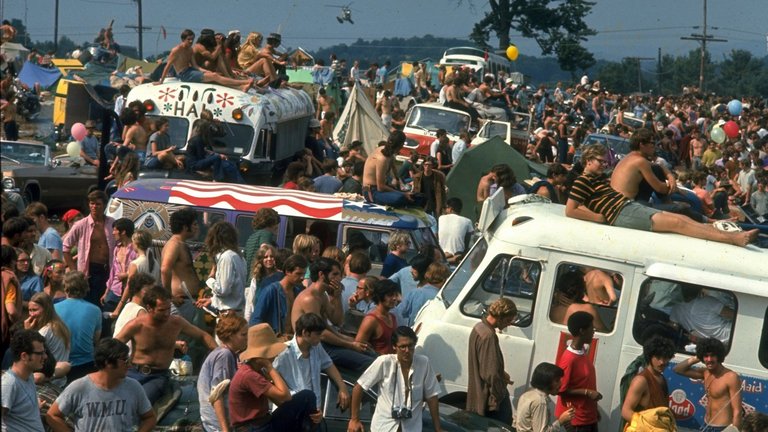Film Review: Woodstock (1970)

The term “rockumentary” emerged in 1969, heralding a cinematic subgenre that would dominate the following decade. This rise paralleled rock music’s ascension as a cornerstone of global pop culture, fuelled by audiences craving unfiltered depictions of the “sex, drugs, and rock’n’roll” ethos—experiences the censored confines of television could not provide. That same year, an event crystallised rock history’s most fabled mythology: the Woodstock Music and Art Fair. Captured in Michael Wadleigh’s 1970 documentary Woodstock, the festival became the defining rockumentary, immortalising the era’s spirit while shaping the genre’s aesthetic and commercial trajectory.
Held between 15th and 18th August 1969 on Max Yasgur’s dairy farm in Bethel, New York, the Woodstock festival—officially a profit-driven venture—descended into chaos as nearly half a million attendees overwhelmed its rural setting. Forced to abandon ticketing, organisers transformed it into a free concert, an unplanned act of generosity that inadvertently birthed the “Woodstock Nation” mythos. Despite torrential rain, logistical disarray, and widespread drug use, the event defied expectations, emerging as a utopian emblem of 1960s counterculture. The festival’s purported harmony—a three-day microcosm of peace, love, and anti-establishment idealism—stood in stark contrast to the Vietnam-era tensions fracturing America, etching itself into cultural memory as both a triumph and a fleeting illusion.
Central to Woodstock’s legend was Wadleigh’s documentary crew, whose exhaustive footage of performances and crowd dynamics preserved the festival’s anarchic grandeur. Edited into a three-hour epic, the film transcended the concert’s financial losses to become a box-office phenomenon, proving the commercial viability of countercultural narratives. Critics lauded its visceral authenticity, culminating in a 1971 Academy Award for Best Documentary Feature—a rare mainstream embrace of hippie iconography. The film’s success lay not merely in documenting history but in mythologising it, transforming mud-soaked disarray into a romanticised vision of communal rebellion.
Wadleigh’s editorial choices balanced musical performances with vignettes of the festival’s human tapestry. While over half the runtime features iconic acts like The Who and Crosby, Stills, Nash & Young, the film intercuts these with candid interviews: locals oscillating between scepticism and solidarity, attendees chasing romance, and couples musing on free love. Scenes of nudity, marijuana use, and discussions of “bad acid” trips catered to the era’s burgeoning exploitation cinema trends, ensuring the film’s allure in a Hollywood increasingly shedding puritanical restraints. This blend of hedonism and idealism offered audiences both voyeuristic titillation and a vicarious taste of rebellion.
Though largely apolitical, the film subtly nods to the era’s turmoil. Joan Baez, mid-performance, dedicates a song to her imprisoned husband, anti-war activist David Harris, while Country Joe McDonald’s sardonic “Fish Cheer” explicitly lambasts the Vietnam War. Yet such moments are fleeting; Wadleigh’s lens predominantly frames the crowd as a harmonious collective, revelling in escapism rather than activism. This selective portrayal drew criticism for sanitising the festival’s rougher edges, yet it cemented Woodstock as a beacon of utopian possibility—one soon dimmed by the violence of Altamont and the counterculture’s gradual dissolution.
Technically, Woodstock pioneered split-screen techniques to compress its sprawling narrative without sacrificing depth. Juxtaposing performances with crowd reactions or backstage chaos, Wadleigh crafted a dynamic visual rhythm, amplifying the festival’s cacophony. The editing team—including a young Martin Scorsese and his future collaborator Thelma Schoonmaker—deserves acclaim for their innovative montages, which balanced frenetic energy with narrative coherence. Such methods, though inspired by 1960s experimental cinema, achieved unprecedented emotional resonance here, immersing viewers in the festival’s sensory overload.
In 1994, Wadleigh released Woodstock: 3 Days of Peace & Music, a director’s cut restoring 40 minutes of excised footage. Additions like Janis Joplin’s raw, soul-baring rendition of “Work Me, Lord” and Jimi Hendrix’s incendiary “Star-Spangled Banner” deepened the film’s emotional heft, foregrounding artists whose truncated performances in the original mirrored their tragically abbreviated lives. This expanded edition reaffirmed the documentary as a living archive, its legacy evolving alongside cultural reappraisals of the 1960s.
Ultimately, Woodstock transcends mere nostalgia. For later generations, it serves as both a time capsule and a cautionary tale—a portrait of idealism unmoored from reality. The film’s idyllic vision of community collides with the knowledge of the movement’s impending collapse: the Altamont disaster, the Manson murders, and the co-option of counterculture by commercial forces. Yet its power endures, not only through electrifying performances but in its unvarnished glimpse into a moment when half a million youths dared to envision a world governed by peace, love, and music. Wadleigh’s masterpiece remains less a eulogy for lost innocence than a testament to the enduring allure of collective transcendence—however ephemeral it may prove.
RATING: 8/10 (+++)
Blog in Croatian https://draxblog.com
Blog in English https://draxreview.wordpress.com/
InLeo blog https://inleo.io/@drax.leo
Hiveonboard: https://hiveonboard.com?ref=drax
InLeo: https://inleo.io/signup?referral=drax.leo
Rising Star game: https://www.risingstargame.com?referrer=drax
1Inch: https://1inch.exchange/#/r/0x83823d8CCB74F828148258BB4457642124b1328e
BTC donations: 1EWxiMiP6iiG9rger3NuUSd6HByaxQWafG
ETH donations: 0xB305F144323b99e6f8b1d66f5D7DE78B498C32A7
BCH donations: qpvxw0jax79lhmvlgcldkzpqanf03r9cjv8y6gtmk9
Posted Using INLEO
It's interesting to consider the balance between idealism and escapism, as I think it offers more of a romantic image of the festival than a critique.